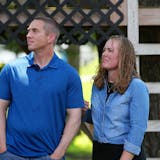St. Paul is looking to use tax-increment financing to clean up the soil at the future site of the Minnesota United stadium after the city's plan to secure grant money for the work fell through.
City leaders agreed last year to cover $1.5 million worth of remediation on a portion of the stadium site where the Metropolitan Council used to store buses. St. Paul Finance Director Todd Hurley said he thought the city could cover its costs with grant money secured by the St. Paul Port Authority, which is leading the remediation efforts.
"We were not looking to use any city funds on the remediation of this," Hurley said.
But restrictions on the state and Met Council's grant programs meant their grant money could not be used to fix up the Met Council-owned bus barn site. So Hurley moved to plan B: using tax-increment financing (TIF) from two other Port Authority projects. Tax-increment financing diverts additional tax revenue that a new development generates and uses it to help cover certain development costs.
The board of the Port Authority signed off on the plan last week, and it will go before the City Council for a public hearing July 19.
The Port Authority's Energy Lane and Great Northern business centers are both TIF districts in St. Paul and will have additional revenue beyond what's needed to cover development costs there, said Monte Hilleman with the St. Paul Port Authority. The business centers are not connected geographically to the stadium site, and they are located north and northeast of the property.
St. Paul would use its internal loan fund to pay as needed for environmental remediation work at the stadium site, Hurley said, and then be reimbursed with money from the TIF districts. Hurley said the city hopes to use less than $875,000 of TIF revenue, assuming another Ramsey County grant comes through and covers more of the city's remediation expenses at the stadium site.
The city initially committed the $1.5 million to spur other investment in the bus barn site, Hilleman said.



